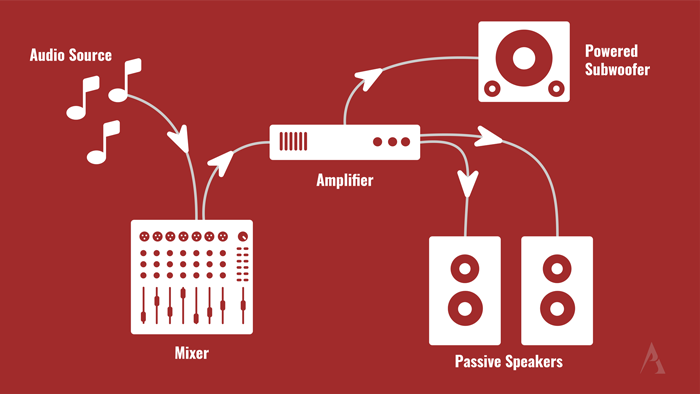We want to show you how to connect an active or powered subwoofer to a passive speaker in your PA system. We are taking the mystery out of connecting active subwoofers to passive speakers by explaining exactly how to set up your system as well as the components you will need.
Before we start talking about how to install a self-powered subwoofer, let's talk a little bit about the two main types of speakers. Generally, speakers are either active/powered or passive/unpowered. The simple difference between the two is that powered PA speakers have a built-in amplifier, and passive PA speakers do not. Active speakers also plug into the wall, whereas a passive speaker plugs into an amplifier.
An audio power amplifier is an electronic amplifier required to amplify the power of an input signal to a high enough level to drive the speakers in your sound system. If you are using passive speakers for your system, you’ll need to make sure you have an audio power amplifier (with sufficient wattage) and a mixer or a mixer amplifier combo.
You can set up your audio system with just these components but you may want to add more low-end bass sound. This is where a subwoofer would come in.
What are subwoofers?
A subwoofer, or sub, is technically a woofer designed to reproduce low-pitched audio frequencies also referred to as bass. The typical frequency range for professional live sound will range around 20–160 Hz. We never recommend that a subwoofer be used alone, as they are intended to fill in the low-frequency range of loudspeakers that cover the higher frequencies. While the term "subwoofer" is technically referring to the driver, the word is commonly used to describe a subwoofer driver mounted in a speaker cabinet.
What is an active or powered subwoofer?
Subwoofers can be passive or active. The basic difference between active and passive subwoofers is the same as we previously mentioned with active/powered speakers and passive speakers. An active/powered subwoofer speaker has a built-in amplifier and a passive subwoofer does not. Powered subwoofers also tend to have other additional features like built-in crossover which is required with subwoofers to limit the frequencies they receive from the amplifier.
Let’s say you want to add a powered subwoofer to your existing PA system that has passive speakers and a powered amplifier. How do you connect a subwoofer with a built-in amplifier to a sound system that already has an amplifier?
How to connect a powered subwoofer to passive speakers?
This seems to be a common question so to clarify, we are not going to be connecting the subwoofer directly to the speakers. We will be installing a powered subwoofer using the line out on our amplifier but we will also walk through the full setup here to make sure you have the complete picture.
For this demonstration, we’ve chosen to use the Crown XLS 1502 power amplifier. First, you’ll take the audio output from your mixer with an XLR or 1/4" cable and plug it into the Crown XLS 1502 channel 1 input.
From there you’ll plug your NL4 Speakon speaker cable, like a CBI SNN142, into the XLS 1502 power amplifier channel 1 output and then run the other end of your speaker cable into the back of your passive PA speaker (above we show the JBL SRX812 12" Passive Speaker). With the Crown XLS amp, we have 2 channels so we could repeat this again for an additional speaker on the other channel.
Then in order to connect your active subwoofer (above we show the JBL SRX818SP 18" Self-Powered Subwoofer) to the amplifier, from the Link Output on the Crown XLS 1502, on the same channel as your mixer, run either an XLR or 1/4" cable (whichever connection you are not using on that channel for your mixer) to your self-powered subwoofer.
This passes the signal through from the amplifier input to the passive speakers, sending this same audio signal to the powered sub. We could repeat this same process with other powered speakers or even feed the input section of another power amplifier.

This makes for a simple, quick, and easy way to add a subwoofer to your PA speaker system for extra bass.
We use this application frequently in schools in cafeterias or gyms, churches, or pro audio systems where extra outputs on a mixer may not be available.
If you have any more questions about connecting a powered subwoofer to passive speakers, give us a call at (888)-256-4112, or email us at [email protected]. Our sound system experts are happy to help!





